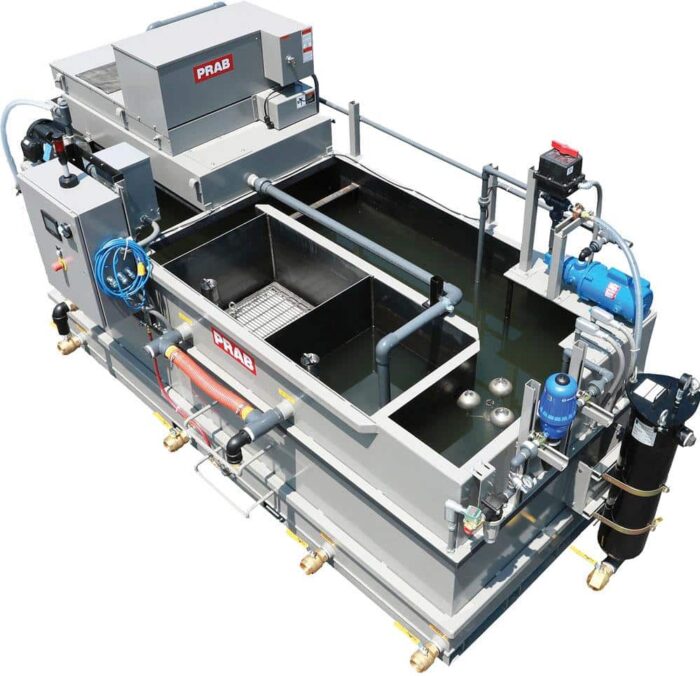
When machining, it is imperative that shops have a strong understanding of how to properly maintain their metalworking fluids. If they don’t, they run the risk of exposing employees to health risks, incurring avoidable costs, and hurting productivity with extended maintenance times.
Here are a few fundamentals to keep in mind when managing metalworking fluids.
Monitor Contaminant Buildup
Regardless of whether an operation is using traditional or synthetic mixtures, metalworking fluids become contaminated with bacteria, tramp oil, and metal fines. If left unchecked, the fluid eventually becomes unusable. For example, fluids contaminated with calcium, chloride, or hydraulic oil exhibit reduced lubricating and cooling capabilities.
Even more concerning are the potential health ramifications resulting from contamination buildup.
Workers who come into contact with water-based fluids contaminated with bacterial byproducts like endotoxins, exotoxins, and mycotoxins run the risk of developing numerous ailments, including skin irritation and respiratory damage. Moreover, from a business perspective, these health problems can lead to medical claims and other financial liabilities.
Reduce Fluid Purchasing Costs
Although not as serious as employee health, fluid purchasing costs have a negative effect on a shop’s bottom line. Not only is there a cost associated with purchasing new fluids, but in their proper disposal as well. Although seemingly superfluous at a glance, these costs add up to a significant amount of money very quickly.
Plan Maintenance Time
As mentioned previously, when metalworking fluid is contaminated, it becomes unusable. If left unchecked, this fluid causes a foul odor, damages equipment, and increases the time needed for maintenance and cleanup. It should go without saying, but the longer it takes to repair or clean equipment, the more an operation’s productivity will suffer. As we can all attest, when productivity declines, so do profits.
Technology Can Help
One way to avoid the problems caused by bad fluid is to implement a fluid management system comprising solids filtration, coolant recycling, and tramp oil separation to extend the life of metalworking fluid.
Large particulate is removed during the pre-filtration process. Solids are removed via secondary filtration options like magnetic separators, paper bed filters, and centrifuges. Tramp oil separators remove free-floating and loosely emulsified tramp oil. The end product is coolant that is ready for reuse.
By removing tramp oils, inverted emulsions, suspended solids, and other contaminants from metalworking fluids, these systems effectively regulate and decrease the presence of bacteria. As a result, the likelihood of ailments like dermatitis and pneumonitis among workers is drastically decreased. In addition to reducing bacteria levels, extending the lifespan of metalworking fluids means less time is spent maintaining equipment.
Regardless of the operation, unexpected tool changes often result in major downtime and a loss in production. While planning machine downtime is something that varies depending on the plant, ensuring that metalworking fluids are maintained is a practice that can be adopted by every operation. Because less contamination and a lower operating temperature come with the clean fluid produced by these systems, tool life is extended, which results in less downtime. The positive financial impact is another benefit of installing a fluid management system.
Fluid replacement costs aren’t always immediately noticeable. In fact, shops may even come to see them as an unavoidable expense. However, estimates1 have indicated that metalworking fluids can make up as much as 10 per cent of the cost of a finished part. A fluid recycling system acts as a turnkey resolution to this issue by providing a consistent flow of clean fluid in the proper concentration back to machines, increasing tool life up to 25 per cent and reducing new coolant purchases by up to 75 per cent.
Returns like these indicate that the fluid recycling system could pay for itself as soon as six to nine months after installation.
Maintaining productivity and avoiding unnecessary cost are crucial components of a successful machining operation, which is why quality metalworking fluid is so important. By implementing fluid filtration systems, shops are better prepared to avoid health risks, decrease fluid purchasing costs, curtail maintenance time, and generate sustainable savings.
Note 1: https://www.prab.com/white-paper-8-problem-areas-affecting-metalworking-operation-profitability
Read the full article at canadianmetalworking.com.

Mike Hook is sales and marketing director, PRAB, 5801 East N Ave., Kalamazoo, Mich. 49048, 877-558-9834, www.prab.com.